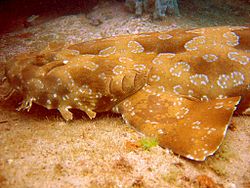 |
| Epaulette Shark |
Sharks of the Hemiscyllidae are usually referred to as
Bamboo sharks, and are often seen in public or even private aquaria as they are
small for sharks and not needing to swim constantly in open water are much more
adapted to life in captivity. Epaulette sharks are usually under 1m long when
mature, and the other members of the family are usually under 1.5m at the
largest.
 |
| Spotted Wobbegong |
The order Epaulette sharks belong to, the Orectolobiiformes or Carpet Sharks mostly live close to the sea bottom, taking crustaceans and small fishes. Some of the
larger species like the often filmed Wobbegong, Orectolobus maculatus, are ambush predators of passing fish. One aberrant
species however has taken to an open water existence and feeds on plankton.
This has enabled it to grow to the largest of all fishes, the famous Whale shark
Rhynchodon typus, which reaches 14m. By
contrast, its relative the Barbelthroat Carpet Shark Cirrhoscyllium expolitum grows
to under 30cm.
 |
| Whale Shark |
Epaulette sharks have the typical lifestyle of the family,
searching in shallow water around reefs for worms and crustaceans, although
they also take small fish sometimes. These prey items may be dug out of the
sand or sucked out of crevices – these sharks have adaptations to their mouth
musculature to enable them to do this. Smaller individuals tend to take softer
bodied prey, with adults taking harder items. Their teeth can flex down in the
mouth to create a hard plate for crushing crab shells if they wish.
They are mostly nocturnal and hide away during the hours of
daylight in crevices between coral heads. Living in shallow water may result in
their being trapped in tidal pools where oxygen levels can fall to low levels
and temperatures can vary considerably from the open ocean, and to cope with
this they have a variety of physiological adaptations to low oxygen levels.
This adaptation is so effective they can survive with zero oxygen for over an
hour, even at tropical temperatures.
Locomotion in their favoured habitats is easier with a
flexible body and the ability to use the substrate in propulsion, which is where
their alternative name of Walking shark comes in. They have increased
flexibility in the fin rays which enables them to move their pectoral and
pelvic fins as legs. Their proficiency with these is so great they can even
leave the water and “walk” back to the sea or another pool of required – there
is one account of one being seen to travel 15m overland in this way.
Reproduction in Epaulette sharks is via eggs. Females lay
between 2 and 4 eggs every 14 days during the breeding season from August to
December, which take around 125 days to hatch as 15cm neonates. As with most
shark species they are slow growing and long lived, taking around 7 years to
reach maturity. Lifespan is probably around 20 years or more.
As these fish are not hunted commercially, except for a very
limited aquarium trade, they do not face much in the way of threats from
overfishing, unlike many open water species of shark. Currently they are
classed by the IUVN as Least Concern.
Images from Wikipedia
No comments:
Post a Comment